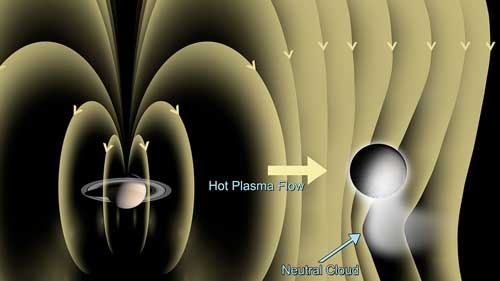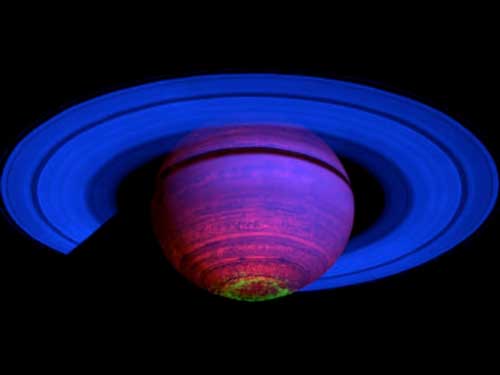| Sep 18, 2017 |
What we're hoping to learn from the magnetic readings of Cassini's final orbits
|
|
(Nanowerk News) It was a proud but sad moment when NASA announced that mission control had lost the signal from the Cassini spacecraft on September 15. As it takes the signal over an hour to travel from Saturn to Earth, this meant that the spacecraft had already been destroyed in Saturn’s atmosphere.
|
|
I was at Caltech in the US, watching the final moments of action on big screens together with mostof the other scientists, engineers and project managers who have worked very hard to make Cassini a success. The spacecraft, now a memory, leaves us with an enormous legacy – a dataset that will take decades to fully exploit. In fact, I’m sure it’ll launch many more scientific careers in the process.
|
|
I am co-investigator on Cassini’s magnetometer instrument. Using measurements of magnetic fields around Saturn, we have probed the planet’s interior as well as the environments of its moons Titan and Enceladus.
|
|
The magnetometer is an instrument with sensors perched on an 11-metre boom, which extends out from the side of the spacecraft. This arrangement is necessary to minimise the interference of magnetic fields caused by the spacecraft electronics.
|
|
Scientists on our team have been mapping the magnetic field generated inside Saturn since 2004. We have also mapped the planet’s 'magnetosphere' – an enormous region or 'bubble' of space around the planet which is influenced by its magnetic field. The region, filled with charged particles called plasma, produces a cavity in the flow of particles from the sun (the solar wind).
|
 |
| This artist concept shows the detection of a dynamic atmosphere on Saturn's icy moon Enceladus. The graphic shows the magnetic field observed by Cassini, as well as the predicted neutral cloud being vented from the south pole. (Image: NASA)
|
|
Our instrument was the first to report something unusual at the first flybys of Enceladus. The field measurements indicated that Enceladus seemed to have something like a very extended 'atmosphere' of sorts. These data were sufficient to convince mission control to fly even closer to Enceladus on the next flybys – enabling the spacecraft to obtain images of incredible water plumes, or geysers, from cracks in the icy surface of the moon. We now know that this source of water is also the principal source of plasma in the planet’s magnetosphere – making the small moon a tiny but powerful engine that drives the much more enormous magnetosphere of its parent planet.
|
Deep mysteries
|
|
Saturn’s internal field is almost perfectly symmetric about the planet’s axis of rotation – making it almost unique among the planets that have magnetic fields, such as Earth. Magnetic fields are produced by electric currents. On Earth, the magnetic field is produced by a fluid movement of molten iron around the planet’s core. It is unclear exactly how Saturn’s magnetic field is produced. We think its interior contains a layer made up of hydrogen that’s been crushed into a metallic liquid. Currents in this liquid are probably the cause of the strong magnetic field.
|
|
Cassini’s last few orbits, which brought it closer to the planet than it has ever been, will be critical to solve this and other questions. The data may help us confirm whether there are any other features of its interior that could be generating its magnetic field.
|
|
We are also hoping to accurately measure a tiny part of the field that we know isn’t symmetrical. This could help us to unambiguously pin down the rotation period of Saturn itself – that is, the exact length of a day (we currently think it is about 10 hours and 47 minutes). That’s because gas giants do not have a solid surface to track, which can make it hard to measure their exact rotation periods. Scientists have previously measured the repetition of radio signals as a proxy, but values based on such measurements vary. Measurements of changes in the magnetic field as the planet rotates, however, may be more reliable.
|
 |
| False-color image showing aurora at south pole. (Image: NASA/JPL/University of Arizona/University of Leicester)
|
|
Cassini confirmed the earlier discovery by the Voyager spacecraft that there’s a periodic 'signal' in the magnetic field throughout the planet’s magnetosphere. We have good reason to believe that this signal is an indication of energy being transferred from flows in the planet’s atmosphere out to its magnetosphere. This energy is transported over distances of millions of kilometres, and the magnetic field acts as the 'wire' along which this energy is transported. Understanding the process is important – we know that this 'coupling' between the planet’s atmosphere and magnetosphere also plays a central role in the physics of auroras (northern lights) and plasmas at Saturn and other magnetised planets.
|
|
Our team is just one of many working on data collected by Cassini, meaning it’s likely we will learn a lot more about the planet as we go forward. For now, the end of mission should be viewed as a commemoration of an enormously successful international, scientific project – and a timely reminder of what humans can achieve when we respect each others’ abilities and differences, so that we can work together towards a common goal. So, goodbye Cassini, you will be missed but never forgotten.
|


